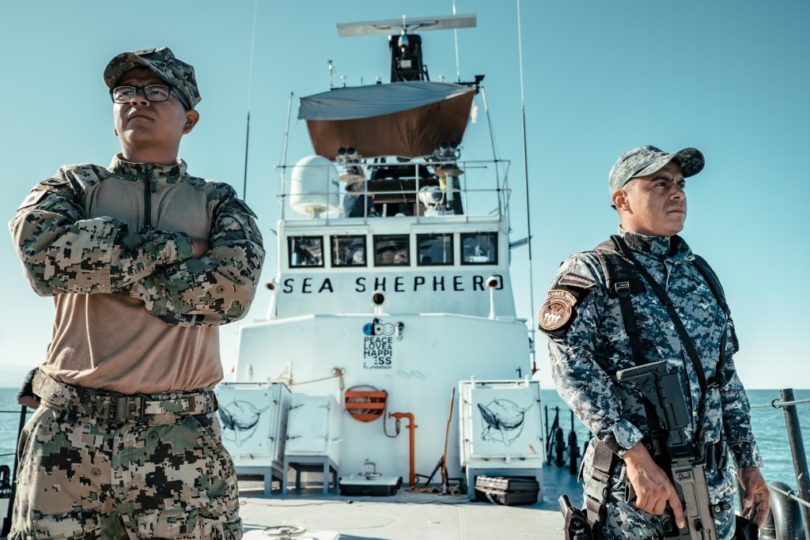Expedition Sights Endangered Vaquita Porpoise and Rampant Fishing Inside Biosphere Reserve
Published by Sea Shepherd Conservation Society
Sea Shepherd ship M/V Farley Mowat and Museo de la Ballena research vessel Narval encounter dozens of skiffs fishing with prohibited gillnets near a live vaquita inside protected Refuge
San Felipe, BC, Mexico, October 23rd, 2019 – Leading scientists, supported by conservation patrol vessels carrying out the second leg of a scientific expedition to study the critically endangered vaquita porpoise (Phocoena sinus), have encountered dozens of fishing skiffs, including one in close proximity to a live vaquita, within the 150 square kilometer “zero tolerance” area of the federally protected Vaquita Refuge in Mexico’s Biosphere Reserve of the Upper Gulf of California and Colorado River.

The skiffs, setting and retrieving prohibited gillnets mainly for shrimp, chano and corvina fish, numbered over 70 altogether and were sighted in groups of up to 28 at a time by crews and scientists on board the vessels M/V Farley Mowat and Narval during the morning of October 17th. The vessels departed San Felipe Harbor at 05:00 am and by 07:34 am photographed a vaquita, the world’s most endangered marine mammal, within a few feet of a fishing skiff inside the “zero tolerance” area recommended by CIRVA (the International Committee for the Recovery of the Vaquita).
This latest photograph of a live vaquita, with a fishing skiff right behind it, was taken in the same area where Sea Shepherd found a dead vaquita caught in a gillnet last March. “Unfortunately, these pangas are exactly where we saw the remaining vaquitas during the last sighting voyage,” said veteran Sea Shepherd Captain Octavio Carranza, concluding “This is also where we found a dead vaquita tangled in a gillnet a few months ago.”
Fishing inside the refuge is banned to protect the critically endangered marine mammal. Subsidies given to the fishermen by the Mexican Government to compensate for this measure ceased to be disbursed 11 months ago. Ramon Franco, President of the Cooperativas Ribereñas Rubio Castro from San Felipe, Baja California stated, “We want the United Nations to know that the fishing sector in our community went out fishing without respecting agreements or protected areas as a result of the lack of attention and dialogue the federal Government has given to this issue, it is responsible for what could happen in this community.”

The result is hundreds of pangas have been returning to sea. “We are between a rock and a hard place: between organized crime and the problems derived from illegal activities in the area, and pressure towards the commercial fishing sector by the government. Those most affected are our fishing organizations that stick to the rules. Those who most benefit are the illegal fishers” said Carlos Tirado, Leader of the Federación Regional de Sociedades Cooperativas Pescadores de la Reserva de la Biosfera, S.C, de R.L de CV, “immediate attention from the President needs to be given to this matter,” he concluded.
These recent incursions into the refuge come despite Mexico pledging to heighten enforcement in the area, and highlights the real and present danger facing the vaquita as well as the underlying socio-economic and enforcement issues that continue to plague the Upper Gulf region. Diego Sabio, Director of Museo de la Ballena considers “the current situation is unbearable for the fishermen, the vaquita and for any actions or policies being implemented to protect this critically endangered animal”.
The Mexican Navy’s Valle Class Oceanic Patrol vessel Escobedo is presently in the Upper Gulf of California and is scheduled to participate in net retrieval operations this month. A Navy interceptor or fast boat was called to the scene to inspect the skiffs. No arrests were made.



Lorenzo Rojas-Bracho, head of marine mammal research at Mexico’s National Commission on Protected Areas (CONANP) and co-chief scientist of the current expedition, highlighted the importance of the sighting: “Under the current circumstances, the most important piece of information right now is that there are still vaquitas surviving… hopefully we can track the lives of these few fit individuals and protect them exactly where they are. These type of expeditions are key to the photo ID effort, they provide the best option to guide protection measures.”
“It is heartbreaking that with less than 20 vaquitas left, this small critical area is still impacted by gillnets” stated Sea Shepherd Campaigns Director Captain Locky MacLean, continuing “We welcome the recent announcement by Mexico’s SPCC (La Secretaría de Seguridad y Protección Ciudadana) to increase capacity in the region, immediate action, collaboration and understanding with government and artisanal fishers is needed now more than ever, to keep the critical zone clear of danger for the vaquita porpoise”.
The expedition to spot vaquitas is coordinated by CONANP with the collaboration of Museo de la Ballena y Ciencias del Mar and Sea Shepherd Conservation Society as well as the participation of researchers from the Autonomous University of Baja California Sur (UABCS) and the USA, and the ongoing support of the Mexican Navy (SEMAR). The first leg of the expedition generated three sightings of vaquita pairs, on August 19th, 20th and on September 3rd, in the waters off San Felipe, Baja California, the second leg of the survey runs between the 14th and 28th of October. The elusive and critically endangered species is being driven ever closer toward extinction by becoming ensnared in gillnets, the primary cause of its decline.



